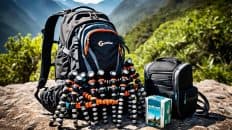Plant identification is a useful skill for travelers who enjoy exploring nature. With the advancement of technology, there are now various tools and resources available to help identify plants on the go. In this article, we will explore the best travel plant identification guide and provide tips for identifying plants while traveling.
Key Takeaways:
- Travel plant identification is a valuable skill for nature enthusiasts.
- Technology has made it easier to identify plants while traveling.
- There are various tools and resources available for travel plant identification.
- Online plant identification classes and resources can enhance your skills.
- Having the right tools, such as a hand lens, is essential for accurate identification.
The Benefits of Travel Plant Identification
Travel plant identification offers many benefits to travelers. By being able to identify plants, you can gain a deeper understanding of the environment you are exploring. Additionally, knowing which plants are safe to touch or consume can help keep you safe during your travels. With the best travel plant identification guide, you can easily learn about different plant species and their characteristics, making your travel experience more enriching.
“Being able to identify plants in the wild has allowed me to appreciate the beauty and intricacies of the natural world. It’s like discovering a hidden language that connects us to our surroundings.” – Jane Smith, avid traveler and plant enthusiast.
When you can identify plants during your travels, you’ll find yourself immersed in a world of botanical wonders. Here are some key benefits of travel plant identification:
A Deeper Connection with Nature
By recognizing the different plant species you encounter, you develop a deeper connection with the natural world around you. It allows you to appreciate the diversity and complexity of plants, their unique adaptations, and the vital role they play in ecosystems.
Safe Exploration
Knowing which plants are safe to touch or consume is crucial for your safety while traveling. Travel plant identification equips you with the knowledge to avoid harmful or poisonous species, preventing any unintentional contact that could lead to adverse reactions or illnesses.
Environmental Awareness
Identifying plants helps you understand the ecological balance of the regions you visit. You can learn about invasive species and their impact on native plants, contributing to the preservation and conservation efforts of delicate ecosystems.
With travel plant identification, you’ll be able to unlock the secrets of the natural world and embark on a truly enriching travel experience.
Tools for Travel Plant Identification
When it comes to identifying plants while traveling, there are various tools that can assist you. These tools streamline the identification process, allowing you to learn more about the plants you encounter on your journeys. One popular option is to use plant identification apps, which leverage image recognition and AI algorithms to identify plants based on photos uploaded by users.
Some of the best plant identification apps include:
- iNaturalist – This app not only identifies plants but also allows you to contribute to scientific research by sharing your observations with the iNaturalist community.
- PlantSnap – With a database of over 500,000 species, PlantSnap offers quick and accurate plant identification. It also provides detailed information on each plant, helping you learn more about their features and properties.
In addition to apps, you can also rely on traditional field guides and online resources for plant identification. Field guides provide comprehensive information about different plant species, including their characteristics, habitats, and distribution. Online resources, such as websites and forums dedicated to plant identification, offer a wealth of knowledge shared by experts and enthusiasts alike.
| Tool | Description |
|---|---|
| Plant Identification Apps | Use image recognition and AI algorithms to identify plants based on photos uploaded by users. |
| Field Guides | Traditional books that provide comprehensive information about different plant species. |
| Online Resources | Websites, forums, and online communities dedicated to plant identification. |
With these travel plant identification tools at your disposal, you can easily explore the world of plants and gain a deeper appreciation for the natural wonders around you.
Learning Plant Identification Online
If you prefer to learn plant identification online, there are several options available. Online classes offered by organizations like NC State Extension Gardener provide comprehensive lessons on plant identification. These classes cover topics such as botanical terms, key features, and different plant species. Participating in these classes can enhance your travel plant identification skills and make your botanical adventures more enjoyable.
By enrolling in online plant identification classes, you gain access to expert knowledge and guidance from experienced instructors. These classes are designed to cater to individuals with various levels of experience, from beginners to advanced learners. Whether you’re a novice traveler interested in plant identification or a seasoned explorer looking to expand your knowledge, online classes offer a flexible and accessible way to learn at your own pace.
Why Choose Online Plant Identification Classes?
Online plant identification classes provide numerous benefits for travelers:
- Flexibility: You can learn at your own pace and choose the most convenient time for studying.
- Comprehensive Content: Classes cover essential plant identification topics, enabling you to develop a well-rounded understanding.
- Expert Instruction: You learn from experienced instructors who can provide valuable insights and guidance.
- Interactive Learning: Many online classes include interactive exercises and quizzes to reinforce your understanding.
Moreover, online plant identification classes often provide access to additional resources such as online forums or discussion boards. These platforms allow you to connect with fellow plant enthusiasts, ask questions, and share your discoveries. It’s a great way to build a community and learn from like-minded individuals who share your passion for travel plant identification.
Below are some reputable organizations offering online plant identification classes:
- NC State Extension Gardener: Offers online courses on plant identification and other horticultural topics. Their classes provide in-depth knowledge and practical skills applicable to various regions.
- Botanical Gardens and Arboretums: Many botanical gardens and arboretums offer online courses and webinars, covering a wide range of plant-related topics, including identification.
By taking advantage of these online resources, you can enhance your travel plant identification skills and embark on botanical adventures with confidence.
Online Plant Identification Classes
| Organization | Course Title | Description |
|---|---|---|
| NC State Extension Gardener | Plant Identification 101 | A comprehensive course covering the basics of plant identification, including plant families, botanical terms, and common plant species. Suitable for beginners. |
| Botanical Gardens Online | Exploring Native Flora | An exploration of native plant species and their identification. The course delves into the unique characteristics of various regions. Suitable for intermediate learners. |
| Plant Enthusiasts Society | Advanced Plant Identification | An advanced course tailored for experienced plant enthusiasts. Covers in-depth knowledge of plant families, specialized identification techniques, and rare species. |
Enrolling in online plant identification classes is a fantastic way to develop your skills, expand your knowledge, and enhance your travel experiences. By learning from experts and actively participating in the online community, you’ll become a confident and proficient traveler in plant identification.
Using Online Plant Identification Resources
When it comes to travel plant identification, online resources can be a valuable tool for travelers. Two excellent resources for plant identification are the NC Extension Gardener Plant Toolbox and the NC State Herbarium Online Keys.
The NC Extension Gardener Plant Toolbox is a comprehensive resource that offers information about horticultural species and their identification based on specific traits. With its vast database and user-friendly interface, this toolbox provides a reliable guide for travelers looking to identify plants during their journeys.
The NC State Herbarium Online Keys is another valuable resource for accurate plant identification. This online platform offers dichotomous keys and image galleries that enable travelers to identify plants with precision. By using these keys, travelers can navigate through a series of choices, leading them to the correct identification.
By utilizing these online plant identification resources, you can easily identify plants while traveling and expand your knowledge of different plant species. Whether you’re exploring a national park, a botanical garden, or simply wandering through nature, these tools will enhance your travel experience by providing valuable insights into the plant life around you.
| Online Resources | Description |
|---|---|
| NC Extension Gardener Plant Toolbox | A comprehensive resource for horticultural species identification based on traits. |
| NC State Herbarium Online Keys | Provides dichotomous keys and image galleries for accurate plant identification. |
Recommended Books for Travel Plant Identification
As a traveler interested in plant identification, having a reliable plant identification guide is essential. There are several recommended books available that can help you identify plants while traveling.
“Wildflowers of the Atlantic Southeast”
This recently published book is a valuable resource for plant enthusiasts exploring the Atlantic Southeast region. It provides detailed descriptions, distribution maps, and high-quality photos of wildflowers, allowing travelers to easily identify the diverse plant species they encounter. With its comprehensive information, this guide is a must-have for any traveler looking to uncover the beauty of wildflowers in the Atlantic Southeast.
Other Recommended Books:
- Native Trees of the Southeast: This book offers comprehensive information on the native tree species found in the Southeast, making it an excellent resource for travelers interested in identifying trees during their journeys.
- Wildflowers and Plant Communities of the Southern Appalachian Mountains and Piedmont: For travelers exploring the Southern Appalachian Mountains and Piedmont regions, this book provides valuable insights into the diverse plant communities and wildflowers of these areas.
Having these recommended books as companions during your travels will enhance your ability to identify plants and deepen your appreciation for the natural world around you. Whether you’re a novice or an experienced plant enthusiast, these resources offer valuable insights and facilitate an enriching botanical adventure.
Essential Tools for Travel Plant Identification
When it comes to travel plant identification, having the right tools is important. One essential tool is a hand lens, which provides magnification for examining plant features up close. Hand lenses are compact and easy to carry, making them ideal for travelers. By using a hand lens, you can observe plant characteristics in detail and accurately identify different plant species during your travels.
With a hand lens, you can focus on specific plant parts such as leaves, flowers, or fruits, allowing you to notice intricate details that aid in identification. The magnification power of a hand lens can vary, with 5x and 10x being common options. Depending on your preference and the intricacy of the plants you encounter, you can choose a hand lens that suits your needs.
When using a hand lens for travel plant identification, it’s important to hold the lens close to your eye and the plant part you wish to examine. This allows for a clear and focused view. You can gently tilt or rotate the plant part to better observe its structures and patterns, ensuring a more accurate identification.
Some hand lenses also come with built-in LED lights, which can be useful for examining plants in low-light conditions or shaded areas. The illumination provided by the LED light helps enhance the visibility of plant features, making it easier to identify them.
Another benefit of using a hand lens for travel plant identification is that it allows you to engage more deeply with the natural world. By taking the time to closely observe and identify plants, you can develop a greater appreciation for their diversity and beauty.
“Using a hand lens for plant identification is like unlocking a hidden world of intricate details. It adds a sense of wonder and discovery to my travels, as I uncover the unique features of each plant I encounter.”
In addition to hand lenses, there are other tools that can aid in travel plant identification, such as field guides and online resources. By equipping yourself with these tools, you can confidently identify plants during your travels and deepen your understanding of the natural world.
Useful and Edible Plants to Identify
When traveling, it can be fascinating to discover the various plants that exist in different regions. Not only are there plants that offer useful properties, but there are also edible plants that can be a valuable addition to foraged meals. By learning to identify these plants, travelers can enhance their exploration of nature and even incorporate them into their culinary adventures.
Wood Sorrel
One plant to look out for is Wood sorrel. This plant has distinctive heart-shaped leaves and provides a sour taste that adds a refreshing element to dishes. Wood sorrel can be used in salads, sauces, or even as a garnish for cocktails. Its tangy flavor makes it a versatile ingredient for adding a twist to your meals.
Plantain
Plantain leaves are another useful plant that travelers should learn to identify. This common plant can serve as a natural remedy for insect bites and inflammation. By crushing the leaves and applying them to the affected area, travelers can find relief from itching and irritation. Plantain leaves are easily accessible and offer a convenient solution for minor skin discomforts during your travels.
Stinging Nettle
Despite its name, Stinging nettle has numerous benefits when properly prepared. This plant is a highly nutritious green that can be used in teas or added to meals. Stinging nettle is rich in vitamins, minerals, and antioxidants, making it a healthy and flavorful addition to your travel cuisine. Be sure to handle this plant with care to avoid any unwanted stings!
Salal and Oregon Grape
When exploring the Pacific Northwest, keep an eye out for Salal and Oregon grape. These plants offer edible berries that are commonly used in culinary creations. Salal berries have a slightly sweet taste and can be enjoyed fresh, added to jams, or used in baking. Oregon grape berries have a tart flavor and are often used as a natural food coloring. Identifying and harvesting these berries can turn your travels into a flavorful adventure.
By familiarizing yourself with these useful and edible plants, you can enrich your travel experiences and develop a deeper connection with the natural world. Remember to always exercise caution and avoid consuming any plants that you are unsure of. Happy foraging!
Note: The image above showcases some of the mentioned plants and serves as visual inspiration for their identification.
Plants to Avoid while Traveling
While enjoying your travel adventures, it’s crucial to be aware of plants that should be avoided. Here are some poisonous plants you need to watch out for:
Poison Ivy
Poison ivy is a well-known plant that can cause skin rashes upon contact. It is characterized by its three shiny leaflets and can be found in various outdoor environments. To avoid rashes and discomfort, be cautious and learn to recognize this plant.
Devil’s Club
Devil’s club is a prickly plant commonly found in forested areas, particularly in the Pacific Northwest. Its spiky stems and thorns can cause skin irritation, making it important to steer clear of this plant during your travels.
Cow Parsnip
Cow parsnip, also known as hogweed, can cause a sunburn-like rash when its sap comes in contact with the skin and is exposed to sunlight. This plant is often found in moist areas such as meadows or near streams. Ensure you avoid touching this plant to prevent any discomfort.
Snowberry
Snowberry is a beautiful plant with white berries; however, these berries are toxic if ingested. It’s important to refrain from consuming the berries to avoid any potential adverse effects.
By being aware of these poisonous plants – poison ivy, Devil’s club, Cow parsnip, and Snowberry – you can ensure a safer and more enjoyable travel experience.
| Plant | Description | Habitat | Identifying Features |
|---|---|---|---|
| Poison Ivy | A plant with three shiny leaflets | Found in various outdoor environments | Leaves with a characteristic glossy appearance |
| Devil’s Club | A prickly plant with thorns | Commonly found in forested areas, especially in the Pacific Northwest | Spiky stems and thorns along the branches |
| Cow Parsnip | A plant with large leaves and clusters of white flowers | Often found in moist areas such as meadows or near streams | Tall plant with umbrella-like clusters of flowers |
| Snowberry | A shrub with white berries | Found in various habitats, including forests and open areas | Small white berries on the branches |
The Fascinating World of Plants
Aside from the practical aspects of travel plant identification, there are also fascinating plants to discover during your travels. One such plant is the Man Root, with its unique appearance resembling a long, fluffy white beard. Although not edible or useful, this plant stands out in the wild and adds a touch of curiosity to your botanical adventures.
| Plant | Description |
|---|---|
| Man Root | A peculiar plant with a long, fluffy white root that resembles a beard. Found in various regions, it adds an interesting element to the natural landscape. |
Tips for Successful Travel Plant Identification
To enhance your travel plant identification skills, here are some helpful tips:
-
Familiarize yourself with the best travel plant identification guide and online resources.
Before embarking on your botanical adventures, take the time to explore the best travel plant identification guide and online resources available. These valuable references will provide you with essential information and tools for identifying plants while traveling.
-
Practice using plant identification apps and tools to improve your accuracy.
Utilize plant identification apps and tools to refine your identification skills. By practicing regularly, you’ll become more adept at recognizing the unique characteristics of different plant species and accurately identifying them.
-
Take photos of plants you encounter and use them for identification later.
When you come across unfamiliar plants during your travels, capture clear photos for future identification. These images will serve as a valuable resource when you have access to online plant identification resources or can consult with plant experts.
-
Join online plant identification communities to seek assistance and share your findings.
Engage with online plant identification communities to connect with fellow plant enthusiasts. Seek assistance when you need help identifying a specific plant and share your findings to contribute to the collective knowledge of the community.
By following these tips, you can become a more proficient traveler in plant identification, expanding your knowledge and appreciation of the botanical world.
Example of a Plant Identification App:
Testimonial from a Plant Identification Enthusiast:
“Using online plant identification resources and joining plant identification communities revolutionized my botanical adventures. I now confidently identify plants during my travels and connect with like-minded nature lovers from all over the world!”
Conclusion
Travel plant identification is a valuable skill for adventurers who seek a deeper connection with the natural world. By relying on the Best Travel Plant Identification Guide, along with online resources and tools, you can confidently identify plants and enrich your botanical experiences. Whether you have a passion for discovering useful plants, exploring edible options, or simply immersing yourself in the fascinating world of plants, the art of plant identification adds a new dimension to your travels. Start your learning journey today and unlock the wonders that await!
FAQ
What are the benefits of travel plant identification?
Travel plant identification helps travelers gain a deeper understanding of the environment they are exploring and identify safe and useful plants.
What tools can I use for travel plant identification?
Popular tools for travel plant identification include plant identification apps, field guides, and online resources.
Are there online resources available for learning plant identification?
Yes, online classes and resources offered by organizations like NC State Extension Gardener and the NC State Herbarium provide comprehensive lessons and keys for plant identification.
Are there recommended books for travel plant identification?
Yes, “Wildflowers of the Atlantic Southeast,” “Native Trees of the Southeast,” and “Wildflowers and Plant Communities of the Southern Appalachian Mountains and Piedmont” are highly recommended books for identifying plants while traveling.
What essential tools do I need for travel plant identification?
A hand lens is an essential tool for examining plant features up close during your travels.
What are some useful and edible plants to identify while traveling?
Wood sorrel, plantain, stinging nettle, Salal, and Oregon grape are some useful and edible plants that travelers can learn to identify.
What plants should I avoid while traveling?
Plants like poison ivy, Devil’s club, Cow parsnip, and snowberry should be avoided due to their potential to cause skin rashes, irritation, or adverse effects.
Are there any fascinating plants to look out for while traveling?
Yes, Man Root is an interesting plant with a unique appearance resembling a long, fluffy white beard.
What are some tips for successful travel plant identification?
Familiarize yourself with the best travel plant identification guide and online resources, practice using plant identification apps and tools, take photos of plants for later identification, and join online plant identification communities for assistance and sharing findings.







Add comment